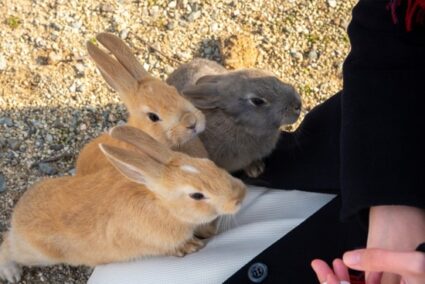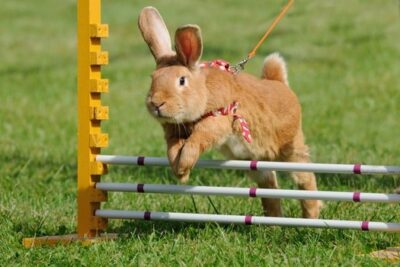Owners don’t always realize just how much exercise rabbits need per day. Their bodies are built for speed, and they need to be active to stay healthy.
Rabbits must have at least 3 hours every day to run around outside their cage. They need a minimum of 32 square feet of space to play in. It doesn’t have to be outside as rabbits are quite happy running around inside the home. Exercise time should be provided at dawn and dusk as this is when rabbits are naturally most active.
Ideally, rabbits should be kept free-range, and allowed unlimited access to the house. If this isn’t practical for you, you must make sure that your rabbit is getting enough exercise. Rabbits that aren’t allowed enough freedom can become stressed, depressed, and overweight.
Do Pet Rabbits Need Exercise?
Domestic rabbits are descended from wild European rabbits. They have been selectively bred to be comfortable around humans, and for their various coat colors and patterns.
Rabbits make great pets as they’re sociable, entertaining and enjoy being petted. But many people don’t realize that rabbits need a lot of exercise. They need more freedom and physical activity than most household pets.
Wild rabbits can reach speeds of up to 35 miles per hour, and cover several miles each day. They spend time chasing other rabbits, foraging for food, and running from predators.
Of course, pet rabbits don’t need to find their own food, nor do they need to escape danger. However, they are still naturally inclined to exercise. They are high-energy animals. If a rabbit does not get enough exercise, it can have physical and psychological consequences. For example:
- Weight gain. Rabbits that don’t exercise enough can become obese. This puts a strain on the cardiovascular and skeletal system. According to the Journal of Animal Physiology and Animal Nutrition, it can cause insulin resistance, which leads to diabetes.
- Boredom. When a rabbit is bored, it can act out in unhealthy ways. For example, it may over-groom itself, creating bald patches. It may gnaw on the bars of its cage, damaging its teeth.
- Behavioral difficulties. Rabbits that don’t get enough exercise usually don’t socialize with humans enough, either. This can lead to them becoming aggressive or destructive.
Exercise Requirements for Rabbits
So, exercise is vital for rabbits. How much exercise do rabbits need? Keeping your rabbit in a cage all day is not an option. Being confined to a small cage or hutch 24/7 can be stressful.
If you do house your rabbit in a cage or hutch, you must let it out for exercise every day. Even the smallest mammals need to be allowed time outside of their enclosure to run around. It’s vital for your rabbit’s mental and physical health.
Rabbits require at least 3 hours of exercise outside their hutch per day. This is a minimum. If you can give your rabbit more time than this, you should. 7 to 8 hours per day is a more acceptable figure.
Ideally, rabbits should be let out twice per day. Rabbits are naturally crepuscular, meaning they’re most active at dawn and dusk. This is because it’s the safest time for wild rabbits. When the sun is low in the sky, predators are easier to see.
Aim to let your rabbit out for exercise from 6-9 am, and then again from 4-8 pm. During the middle of the day, they’ll probably be sleeping, waking up occasionally to nibble at the hay.
Do not force your rabbit to adhere to your schedule. 6 am might seem early, but you should respect your rabbit’s natural circadian rhythm.
Most rabbits can swim, but they don’t all like swimming for exercise. Never force your rabbit into a swimming pool or bathtub just because it’s an activity that you enjoy. It can cause extreme shock.
Amount of Time To Spend with Your Rabbit
When outside of the cage or hutch, you’ll need to provide constant supervision. Rabbits can get into danger if they are left to their own devices. Rabbits have a natural inclination to chew, scratch, and dig. Their teeth and claws grow constantly, and need to be filed down. They also tend to jump on and off of things, and throw items around.

If you only have one rabbit, you should also spend at least 2 hours each day interacting with them one-on-one. Rabbits are social creatures and need to socialize with other animals to keep them happy.
The ideal companion for a rabbit is another rabbit. Two rabbits will establish a strong bond and will keep each other company all day. If you can’t house another rabbit, be prepared to give your undivided attention. You’ll need to get down on the floor with your rabbit and play with it.
How Much Space Do Rabbits Need?
Many people have an unrealistic idea of how much space a rabbit needs. This is because most commercially-sold rabbit cages, pens, and runs were originally designed for livestock rabbits.
Domestic rabbits, on the other hand, have the potential to live for 10 to 14 years. If you want your rabbit to live for a long time, you’ll need to give it plenty of space. Rabbits that are kept in substandard conditions are likely to die far before their natural lifespan. If you’re keeping a pet rabbit, you have several options for its accommodation:
- Give your rabbit free rein of the house. As rabbits can be litterbox trained, many owners choose this option. You’ll have to rabbit-proof the house if your rabbit will have unsupervised access.
- Keep your rabbit in a large, rabbit-proofed pen while you’re asleep. Then, let it out during the day while you can supervise.
- Keep your rabbit in a cage or hutch most of the time, and let it out for supervised exercise. This is the worst option, as most rabbits hate being confined in small, enclosed spaces.
Rabbits should not live outdoors. Outdoor rabbits don’t live as long as house rabbits. They often have their lives shortened by predators, adverse weather, extreme temperatures, or disease.
How Big Should a Rabbit Cage Be?
Rabbits don’t need to live in cages or hutches. It’s unhealthy for them to be cooped up. Ideally, you should set up a large, rabbit-proofed pen indoors for your rabbit to live in. However, if you don’t have space, there are ways of making hutches and cages livable.
A rabbit cage or hutch should be a minimum of 12 square feet in area. For example, it should be 6 feet long, 2 feet wide, and 2 feet high. If your rabbit is a larger breed, it may need more space.
Your rabbit should be able to hop 4 times from one side of the hutch/cage to the other. The width of the hutch should be sufficient for your rabbit to lie fully outstretched. It should also be able to stand on its hind legs without touching the roof.
The cage or hutch should also have a covered part, where your rabbit can feel safe while they sleep. If yours doesn’t, provide a wooden or cardboard box at the very least.
How Big Should a Rabbit Pen Be?
The minimum size of a rabbit exercise pen should be 32 square feet. For example, you could use a 6ft x 6ft or 8ft x 4ft wire run. You could even use a playpen or room divider designed for babies.
Your rabbit pen or run should, ideally, connect to the hutch via a tunnel or ladder. That way, your rabbit can get out and exercise at any time of the day or night. It won’t have to wait for you to let it out.
Your rabbit can also live in its pen or run permanently. If this is the case, the run will need to be bigger. It will need to include space for a covered sleeping area, litter tray, food, and water bowls. If the run is outdoors, it must have a roof to protect your rabbit from aerial predators.
If your rabbit’s pen is not big enough, you’ll need to let it out for exercise. It can roam around the house, or the back yard. Whichever you choose, you must supervise your pet rabbit carefully at all times.
Can I Let My Rabbit Run Around the House?
Many owners let their rabbits have free rein of the house. House rabbits tend to be much happier than rabbits that are kept cooped up.
Rabbits are hygienic animals and can be litter trained. They prefer to carry out their toilet activities in one place. This is because in the wild, leaving poop everywhere would alert predators that rabbits are nearby.
Rabbit-proofing a home is a bit like baby-proofing. Make sure that everything within your rabbit’s reach is safe for it to investigate and chew. If any objects could be harmful, they must be kept high up or in cupboards.
Many owners keep their rabbits confined to one room. It’s easier to rabbit-proof a spare room than an entire house. It’s fine for your rabbit only to have one room, as long as you interact with it regularly.

How To Rabbit-Proof a Room
Rabbit proofing is vital for safety reasons, and to stop your possessions from being destroyed. Here’s how to make a room safe for rabbits:
- Keep all cables and cords out of your rabbit’s reach. Rabbits will instinctively chew cables, as they remind them of roots. Plastic piping works well for keeping cords contained.
- Get rid of all houseplants and vase flowers, or keep them high up out of reach. Many common plants are toxic to rabbits, including daffodils, hyacinths, and irises.
- Put wire mesh, fencing, or baby gates in front of the furniture you want to protect. Rabbits like to chew wooden furniture/ baseboards.
- Block off any areas that you don’t want the rabbit to access. For example, rabbits like to bite holes in clothes, so you may wish to block access to closets. Rabbits can also injure themselves falling down the stairs, so place baby gates at the top and bottom.
- Cover any expensive carpeting with a short-pile, inexpensive rug. Many rabbits love to dig and chew at carpets.
- Never leave anything in your rabbit’s reach that you don’t want it to chew. Clothes, laundry, blankets, laptops, bags, and children’s toys are all fair game for a bored rabbit.
Provide your rabbit with lots of hay, chew toys, and things to interact with. Giving your rabbit plenty to do is the key to keeping them happy. Bored, unhappy rabbits will chew and destroy everything that they can reach.
A spray bottle of water makes a handy deterrent for rabbit training. If your rabbit chews on anything it shouldn’t, give them a quick spritz of water along with a firm “no.” Give them lots of praise whenever they chew on something acceptable, such as a toy.
How Do Rabbits Like To Play?
Rabbits are intelligent creatures, so they need to be provided with mental stimulation. While they do enjoy running around, it’s not all that they like to do. They also like to play, forage, and investigate their surroundings. Here are some ideas for rabbit exercise equipment:
- Exercise wheel. They’re essentially extra-large versions of hamster wheels. Some rabbits love them, whereas others don’t.
- Treat ball. These are hollow plastic or wooden balls that you can conceal treats inside. The rabbit has to push them around to get the treats to fall out. A couple of raisins work well as an incentive.
- Tunnels. There’s just something about tunnels that rabbits can’t seem to get enough of. They love darting through them at top speed.
- Ramps and platforms. Rabbits love jumping onto things and back down again. Create some height for your rabbit’s space by stacking boxes and leaning planks against them
- Cardboard boxes. Rabbits love hiding inside boxes, climbing on and chewing them. This also helps to file your rabbit’s teeth down.
- Buckets of hay or shredded newspaper. Rabbits love digging and burrowing. You can hide treats throughout the hay to make it more exciting. Don’t let your rabbit eat newspaper.
- Wicker balls. Some rabbits love to nudge and chase wicker balls all around the house. They also love to chew on them.
You don’t have to spend a lot of money on rabbit toys. Whatever you give your rabbit to play with, they’ll find a way to make it fun and get exercise. Just make sure that you supervise your pet rabbit closely at all times.

